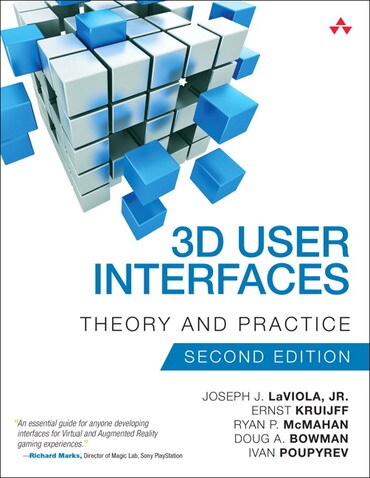
3D User Interfaces: Theory and Practice, 2nd edition
- Joseph J. LaViola |
- Ernst Kruijff |
- Doug Bowman |
- Ivan P. Poupyrev |
- Ryan P. McMahan |
Title overview
From video games to mobile augmented reality, 3D interaction is everywhere. But simply choosing to use 3D input or 3D displays isn't enough: 3D user interfaces (3D UIs) must be carefully designed for optimal user experience. 3D User Interfaces: Theory and Practice, Second Edition is today's most comprehensive primary reference to building outstanding 3D UIs. Four pioneers in 3D user interface research and practice have extensively expanded and updated this book, making it today's definitive source for all things related to state-of-the-art 3D interaction.
This edition goes far beyond VR, covering the full spectrum of emerging applications for 3D UIs, and presenting an extraordinary array of pioneering techniques and technologies. The authors combine theoretical foundations, analysis of devices and techniques, empirically validated design guidelines, and much more. Throughout each chapter, they illustrate key concepts with running case studies on gaming, mobile AR, and robot teleoperation.
- Cutting-edge guidance on designing 3D UIs for optimal user experience, from a team of world-class researchers and practitioners
- Teaches new techniques and technologies for gaming, mobile augmented reality, tactile and haptic displays, human-robot interaction, tele-operation, remote collaboration, and VR
- Covers breakthrough devices such as Oculus Rift, Leap Motion, and Kinect - plus emerging advances in brain input, mobile AR, and beyond
- Now offers deeper practical insight through three complete running case studies
This extensively updated Second Edition adds coverage of new 3D UI systems, trends, technologies, and advances; and will more consistently cover practical issues by introducing three case studies that run throughout the book. It fully reflects major advances, including new generations of interactive systems that have been introduced throughout consumer, research, and industry sectors.
Moving beyond its earlier strict focus on VR, this edition reflects today's far wider applications of 3D technology. The authors have revisited and extended this book's theoretical sections with new insights, updating the examples, and adding novel areas of research. In particular, they focus on true 3D spatial user interfaces where a user's position and orientation is known, and examines research areas that have rapidly grown since the first edition. These include:
- Mobile augmented reality
- Novel tactile and haptic displays
- Gaming
- Human-robot interaction and tele-operation
- Collaborative systems
Table of contents
-
Part I: Background and Introduction
-
1. Introduction to 3D Interaction
-
2. 3D User Interfaces: History and Roadmap
-
Part II: HCI and Human Factors Basics
-
3. General Principles of Human-Computer Interaction
-
4. Human Factors Fundamentals
-
Part III: 3D Interaction Technology
-
5. 3D Output Devices
-
6. 3D Input Devices
-
Part IV: Interaction Techniques for Common 3D Tasks
-
7. Selection and Manipulation
-
8. Navigation
-
9. System Control
-
Part V: Designing and Developing 3D User Interfaces
-
10. Strategies for Designing and Developing 3D User Interfaces
-
11. Evaluation of 3D User Interfaces
-
Part V: The Future of 3D User Interfaces
-
12. The Future of 3D Interfaces
Author bios
ERNST KRUIJFF, Interim Professor for Computer Graphics and Interactive Systems at the Institute of Visual Computing, Bonn-Rhein-Sieg University of Applied Sciences, leads the 3DMi group’s design of multisensory 3D user interfaces.
RYAN P. McMAHAN, Associate Professor of Computer Science at UT Dallas, directs its Future Immersive Virtual Environments (FIVE) Lab.
DOUG A. BOWMAN, Professor of Computer Science at Virginia Tech, directs its 3D Interaction Research Group and Center for Human-Computer Interaction. He is an ACM Distinguished Scientist.
IVAN POUPYREV is Technical Program Lead working on advanced interaction research at Google’s Advanced Technology and Products (ATAP) division.